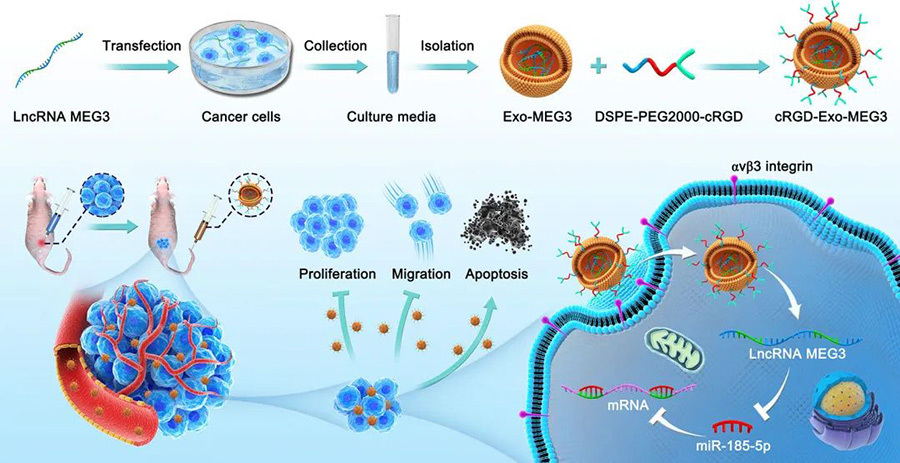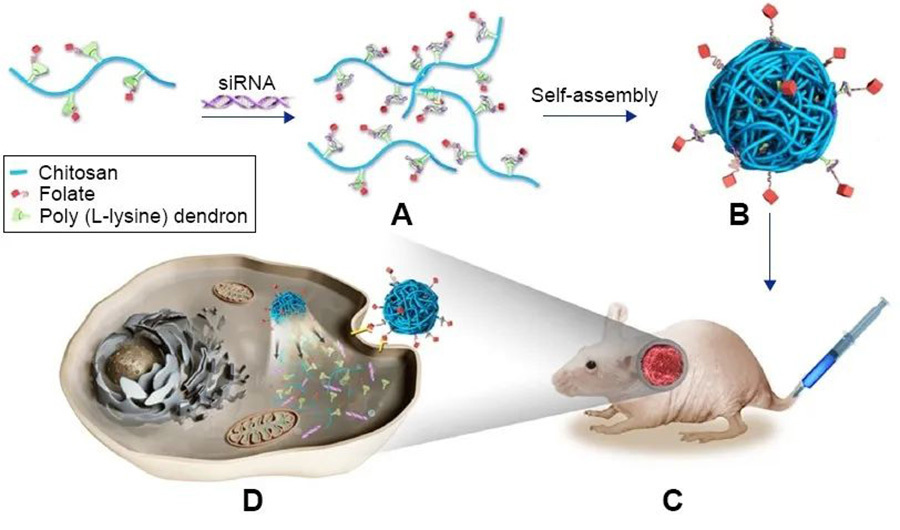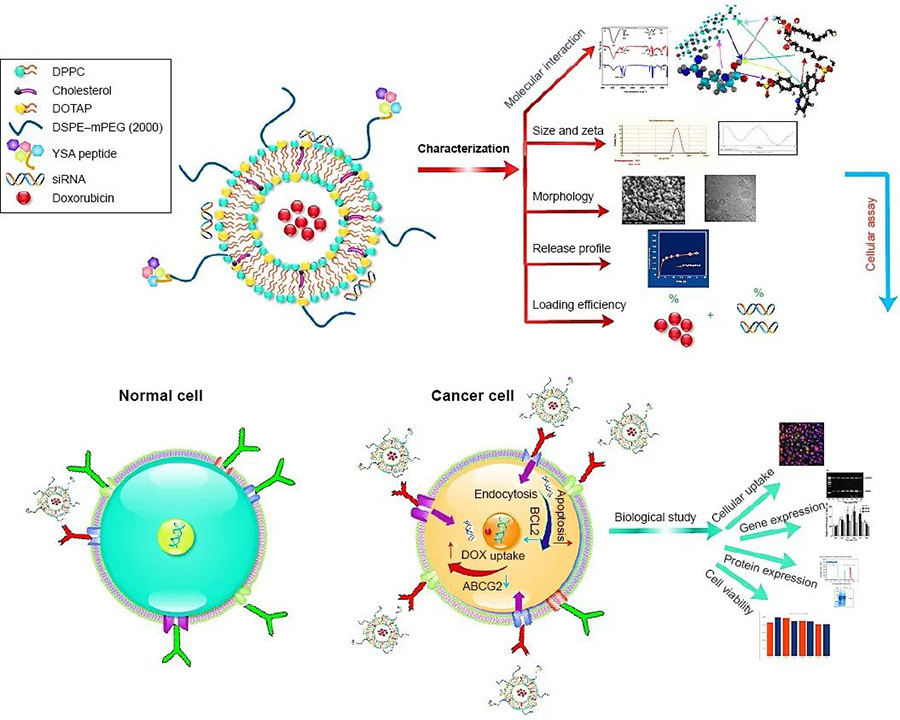11
2023
-
09
An active targeting approach for the treatment of osteosarcoma with nanodelivery systems
Osteosarcoma is the most common in situ tumour of bone, accounting for approximately 35% of bone malignancies. The main symptoms of patients with osteosarcoma include restricted mobility, swelling, severe pain, and pathological fracture, and approximately 10-20% of patients have metastases at the time of their initial consultation. Conventional treatment includes early surgical resection and adjuvant chemotherapy, but a larger proportion of patients still respond poorly to treatment. The current first-line chemotherapeutic agents include adriamycin, cisplatin and methotrexate, which synergistically exert anti-tumour effects through different mechanisms of action, but due to the lack of selectivity of these agents and more pronounced systemic toxicity when applied in high doses, new therapeutic approaches need to be explored.

01 Osteosarcoma
Osteosarcoma is the most common in situ tumour of bone, accounting for approximately 35% of bone malignancies.The main symptoms of patients with osteosarcoma include restricted mobility, swelling, severe pain and pathological fracture, with approximately 10-20% of patients having metastases at the time of their initial consultation. Conventional treatment includes early surgical resection and adjuvant chemotherapy, but a larger proportion of patients still respond poorly to treatment. The current first-line chemotherapeutic agents include adriamycin, cisplatin and methotrexate, which synergistically exert anti-tumour effects through different mechanisms of action. However, due to the lack of selectivity of these agents and the more pronounced systemic toxicity when applied in high doses, new therapeutic approaches need to be explored.
The special tumour microenvironment of osteosarcoma acts as a protective barrier that severely hampers effective drug delivery. Firstly, osteosarcoma has a large histological heterogeneity and genomic instability. Whole genome sequencing has shown that osteosarcoma has a highly abnormal genome with disrupted tumour suppressors, and targeted therapies based on genetic features have limited effects. Secondly, the dense bone matrix contains a large amount of inorganic minerals, which would inhibit the penetration and accumulation of chemotherapeutic agents in the bone tumour, and the bone marrow-blood barrier would also impede the passage of chemotherapeutic agents. Finally, the lack of effective targeting often leads to ineffective accumulation of chemotherapeutic agents at the osteosarcoma site.
02 Targeted Nano Drug Delivery Systems
In the past decades, nanotechnology has demonstrated its superiority in the field of medicine, and drug delivery systems based on nanocarriers have been extensively investigated, and various nano-drug delivery systems such as nanoparticles, nanoliposomes, and nanogels have been applied to deliver chemotherapeutic drugs. Nano drug delivery systems can increase the solubility of some hydrophobic drugs, while reducing the degradation of drugs in the body circulation, and also increase the targeting of drugs and improve the bioavailability of drugs through controlled release.
The targeting type of nano drug delivery system is mainly divided into passive targeting and active targeting. Since the vascular system of the tumour site is more lax compared to normal tissues, the clearance function of lymphocytes is impaired, resulting in some nano-scale particles will be more easily enriched in these tissues, which is the passive targeting of nano-delivery system. Active targeting is to modify the targeting groups such as ligands and antibodies on the nanocarriers to guide the nanocarriers to specifically identify and bind with the tumour cells, and through the endocytosis received by the receptor, the tumour cells will phagocytose the nanocarriers, which will result in a higher therapeutic efficacy and targeting.
The actively targeted nano-delivery system enables more effective accumulation of chemotherapeutic agents in osteosarcoma by targeting specifically expressed targets in osteosarcoma, and the selectable high-affinity targets in osteosarcoma will be described below.
03 Active targeting acting on vascular endothelial growth factor receptors
Tumour growth requires an adequate blood supply, and inhibiting angiogenesis to block the blood supply can inhibit tumour growth. Tumour cells themselves secrete various groups of pro-angiogenic factors, including vascular endothelial growth factor (VEGF), platelet-derived growth factor, basic fibroblast growth factor, etc., and these angiogenesis-related receptors are shown to be overexpressed in many tumour cells.

VEGFR, the receptor for VEGF, is highly expressed in most osteosarcoma cells, and a study has been conducted to construct a nanodelivery system using the interaction of VEGF with VEGFR.The researchers assembled a metal-organic framework ZCD using zoledronic acid, calcium ions, and adriamycin, and then wrapped the ZCD with VEGF-modified erythrocyte membranes, V-R nanobubbles, to form the nanodelivery system for targeted osteosarcoma, V- RZCD.The camouflage of the erythrocyte membrane was able to evade the recognition of the immune system and increase the retention time of the drug in the somatic circulation. The metal-organic framework not only improves the anti-osteolytic effect of zoledronic acid, but also releases calcium ions synergistically. adriamycin in it can not only be used as an anti-tumour drug, but also monitor the aggregation of the drug by red fluorescence, and the experimental results show that it can significantly inhibit the proliferation of osteosarcoma, which is a promising therapeutic strategy.
04 Active targeting acting on integrins
Integral proteins mediate cell-cell and cell-extracellular matrix recognition and adhesion, which can connect the extracellular matrix and intracellular skeletal network as a whole, and can also transmit extracellular signals to the cell to change the expression of some genes in the cell. The arginine-glycine-aspartate sequence peptide (RGD) specifically binds to integrins, and RGD can be used to actively target the αvβ3 integrin receptor, which is highly expressed on the surface of osteosarcoma.

In response to this property, a study used RGD to functionalize lncRNA-MEG3-rich exosomes to construct exosomes that actively target osteosarcoma. The researchers found that lncRNA-MEG3 could inhibit the growth of osteosarcoma cells by targeting the uptake of miR-185-5p, so the tumour cells were transfected using the expression plasmid of lncRNA-MEG3, and the cell culture supernatant was collected to further isolate and obtain the exosomes enriched with lncRNA-MEG3, and then RGD was modified on the surface of the exosomes by DSPE-PEG2000. Then RGD was modified on the surface of exosomes by DSPE-PEG2000 to obtain the exosome-based active targeting nano-delivery system. The results of ex vivo and in vivo experiments showed that RGD modification enhanced the targeting of exosomes to osteosarcoma cells, and compared with non-targeted exosomes, the active targeting exosomes possessed higher proliferation and migration inhibition and apoptosis inducing ability, and significantly reduced the size of osteosarcoma.
05 Active targeting acting on folate receptors
Folic acid is a nutrient required for the growth and proliferation of human cells, and is involved in the synthesis of proteins, amino acids, and nucleic acids in the body. Folate receptor is a cell surface protein with high affinity for folic acid, which can mediate endocytosis and uptake of folate into the cytoplasm of the cell. Folate receptor has a very low expression in normal tissues and a high expression in many kinds of tumour cells including osteosarcoma, and thus it can be Folate receptor-mediated endocytosis can be used to construct an active targeted nano drug delivery system.

A study has developed a nanoscale polysaccharide derivative as a nanodelivery system for actively targeting osteosarcoma. Using click chemistry, the researchers combined azide group-modified chitosan with alkynyl-modified branched polylysine and subsequently coupled folic acid to form the Cs-g-PLLD-FA nanocarrier, which was shown to have no significant cytotoxicity in safety evaluations, and cellular uptake experiments showed that the folic acid modification increased the uptake of the complex by osteosarcoma cells. Since previous studies have shown that the AEG-1 gene is highly expressed in osteosarcoma, and down-regulation of AEG-1 expression can inhibit osteosarcoma growth, the researchers used the nanocarrier loaded with AEG-1 siRNA and delivered it to osteosarcoma cells. The results of the in vitro and in vivo experiments showed that the nano-delivery system could effectively down-regulate AEG-1 expression and inhibit the growth of osteosarcoma.
06 Active targeting at the adrenergic A2 receptor
Adrenergic A2 receptor (EphA2) is a transmembrane glycoprotein belonging to the tyrosine protein kinase receptor, and EphA2 has been shown to have an important role in cancer development. Through EphA2, proteins such as adhesion plaque kinase and extracellular regulated protein kinase can be affected to regulate the proliferation and activity of a variety of malignant tumour cells.EphA2 is also highly expressed on the surface of metastatic osteosarcoma cells, and a 12-amino-acid peptide, YSA peptide, has a very high affinity for EphA2, and thus can be coupled to the YSA peptide to achieve active targeting. YSA peptide to achieve active targeting.

Based on the active targeting property of YSA, the researchers constructed a temperature- and pH-sensitive nanoliposome for co-delivery of chemotherapeutic drugs and genes. Firstly, DOTAP, cholesterol, DPPC, and DSPE-PEG were synthesized into cationic liposomes encapsulating the chemotherapeutic drug adriamycin, followed by further modification of YSA peptide to the surface of liposomes by covalent binding, and finally loading of JIP1-siRNA with adriamycin sensitizing effect by using charge interaction to obtain the active targeting nanoliposome. The results of the activity experiments showed that this liposome had significantly higher killing properties on osteosarcoma cells compared with free adriamycin, inducing 93% apoptosis, while the cytotoxicity to normal bone cells was significantly lower, which has a good prospect for application.
07 Conclusion
The development of nano-delivery systems offers new hope for enhancing drug safety and efficacy by delivering therapeutic molecules, including chemotherapeutic agents, genes and other therapeutic molecules, either individually or in combination, to achieve precise osteosarcoma killing ability, however, there is still room for further improvement in the current study, such as: searching for targets with higher specificity in osteosarcoma, utilising synergistic action of multiple targets to improve targeting, and targeting circulating tumour cells in response to the easily metastatic nature of osteosarcoma. The targeting of circulating tumour cells in osteosarcoma is a characteristic of osteosarcoma that is easily metastasized. In conclusion, nano-delivery systems offer great hope for the treatment of osteosarcoma. Although these emerging nanomaterials are still in the cellular and animal experimental stages, we believe that nanotechnology can revolutionise the clinical treatment of osteosarcoma in the near future.


